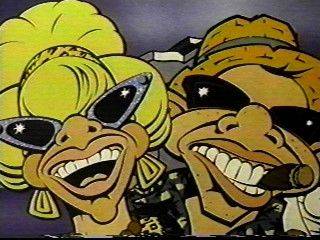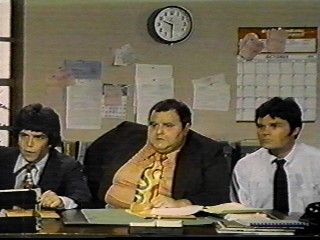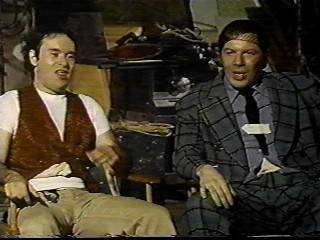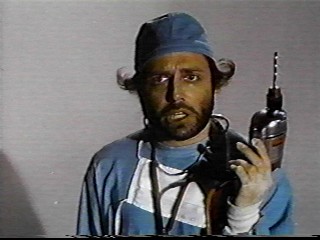
|
|
|
|
|
|
|
|
|
|
|
|
|
(1977) Director: Rowby
Goren & Chuck
Staley
With this review, The Unknown Movies ends its coverage
of a comedy era. That's because after I talk about Cracking Up,
this site will have talked about every movie to be found in the small
sketch/parody genre. You almost certainly know about the more famous
movies in this genre - Cracking Up was created in a different way than all of those other known and unknown sketch/parody movies. Instead of one or a few screenwriters working on the entire script, what was basically done was that some movie producers approached a number of improv comedy troupes that were active in the '70s (The Credibility Gap and Ace Trucking Company among them) and said, "Hey, wanna appear in a movie? Come by and just perform the routines you guys have been doing on the stage." Young and hungry for money and a chance to strike it big, the answer would certainly be "Yes" in almost every case - an ingenious way for the producers to cheaply put together a movie. And some of the people involved in Cracking Up did go on to bigger and better things - you'll see Fred Willard here, "Lenny" and "Squiggy" from Laverne & Shirley (Michael McKean and David L. Lander), and one of the voices on The Simpsons, Harry Shearer. So you might now be thinking questions like, "So if Cracking Up has some now-famous people in it, why isn't this movie better known? If it was made by the same people who were behind the cult classic Tunnelvision, why hasn't it been embraced with the same kind of cult? Why was it only released on video this year?" The answer: It sucks. It's been said that there is nothing worse than an unfunny comedy, but that's not quite it. A badly done comedy is bad enough, but what is even worse is a bad comedy like this one, where it is crystal clear that everyone involved thinks that the garbage they are writing and acting is hilarious. It's one thing to see an actor clearly suffering while doing some particularly lame schtick - you can't help but feel some sympathy - but when they think it's funny, you can't help but feel like it's a direct attack against you. It's like they are laughing at your suffering. Needless to say, this is the kind of comedy delivered in this movie. In hiring these writer/actors, the producers were so obsessed in saving a buck that it seems that they weren't careful to examine if the material they got would make a buck. To add insult to injury, the saving-a-buck attitude also
seems to have gone in the Afterwards the movie jumps back to showing us the results of the 9.7 earthquake. For the next few minutes we see the aftermath of the earthquake, with dead people lying around the wreckage of the city, bloodied and limb-broken people crawling through the debris, and people trapped under overturned cars. (Hilarious, huh?) We get our first taste of comedy here from an overheard radio announcer, and it's not promising - he says such witticisms like, "24 million fatalities - some of them serious" and "The Red Cross is speeding out packets of Rolaids and Alka-Seltzer to bring relief to the 168 known survivors." We shortly afterwards meet the device in this earthquake aftermath footage that is used to introduce the skits. It comes in the form of two idiot television reporters, "Walter Concrete" and "Barbara Haulters", the latter of which is played by a guy in drag. During the course of the movie, when not directly covering the aftermath, they either take breaks for commercials or ask the earthquake survivors, "What were you doing when the quake struck?" - both of which make excuses for the comedy teams' routines to be played before our eyes. A clever linking device, eh? Who cares if the "What were you doing..." skits clearly take place not just during the day, but at night? After all, earthquakes can go on for a long time - right? Goofs like that I could easily look over in a better movie, but when the experience is this painful you can't help but lash out at even the tiniest flaws the movie has to offer. The biggest flaw that keeps coming up over and over
again during the running time is that the movie is so damn unfunny.
Take the first sketch, performed by the lovable (as in only a mother
could love) members of Ace Trucking Company. A job hunter goes to the
office of a wrecking company for a job interview. While he waits for
the vice president of the company to interview him, the man on
reception gives him some advice: The vice president has "a nervous
twitch", so please don't pay attention to it. But ha ha, whadda know -
the guy at reception has a nervous twitch as well, so the poor job
seeker is always wrong when deciding if the receptionist is having a The problem facing most of the sketches in this movie is that the central ideas behind them are ill-conceived or just plain stupid. Because of that, it's tough to imagine even the greatest comedy writers managing to successfully mine the premises for comic gold. Here are some additional examples of sketches that result in "this is supposed to be funny?" reactions instead of laughs:
The cast tries hard to put life into these routines - every actor puts in so much effort into their performances, you've got to admire their hard work at acting. But their written material is just so awful, it becomes kind of pathetic seeing them trying to wring a laugh out of material that doesn't contain a drop of humor. Even the few actors who survived this debacle and went onto receiving acclaim for their comic talents (besides Willard, McKean, Lander, and Shearer, you'll also see Stephen Stucker, who played "Johnny" in Airplane!) just aren't funny here. The only actor who manages to differentiate himself (and in a good way) from everyone else is Willard, not for doing anything funny, but because of some natural charisma. Not only are these routines tough to sit through because
of the awfulness of the writing, but of their shoddiness. Phony or just
plain non-existent sets are just another instance where the producers
saved a buck. But the most blatant example of the producer's cheapness
comes not from the sets, but in the filming of the skits. Actually, I
can't use the word "filming" when it comes to the skits; though In this disaster more devastating than any 9.7 earthquake, one laugh can be found. Yes, despite all the strikes against this movie, it managed to amuse me one time. That was during another (oh no!) appearance by the members of Ace Trucking Company. It's a sketch set at a greasy spoon diner, where a patron comes in just for a hamburger. Despite the kind of restaurant, and the fact the patron is the only customer there, the staff of the restaurant treat him as if he was in a fancy jacket-and-tie supper club. Not long after he's seated, the three staff members begin a show for their customer, singing a song and encouraging their audience to sing along. The absurdity of putting on such a big show for one patron plus the absolutely stunned look on the patron's face made me laugh. However, come to think of it, I don't think that laugh
counts. You see, several years ago I went to a restaurant with my
mother, and we were about the only ones in the restaurant. During our
meal, the restaurant's entertainment started, which was a guy playing
the piano and singing. Despite the restaurant being almost empty, he
kept pleading for his almost non-existent audience to sing along (and
not getting any results.) It amused my mother and I greatly, and I
still smile about it today. Since that sketch had a good chance of
reminding me of that personal amusing incident, I don't think that
laugh can count. So the movie remains laugh-free. Unless you have had a
similar experience at a restaurant (as well as similar experiences with
televangelists, phys-ed teachers, D.A.s, etc.), there is no way that
you'll find anything in Cracking Up remotely funny. I
never thought I would ever come across a sketch/parody movie worse than
Outtakes, but you learn something new all the
time. UPDATE: "Vermin Boy" sent this in: "Hey, just read your review of Cracking Up,
and thought you might want to know that the Credibility Gap and the Ace
Trucking Co. aren't the only notable comedy teams in it. Barbara
Halters and Walter Concrete were played by Peter Bergman and Phil
Proctor, half of the legendary Firesign Theatre, who at that time had a
fairly successful solo (er, duo) career. They did do better film work a
year later, with the much-sought-after, What's Up Tiger Lily-like
movie, J-Men Forever. UPDATE 2: I received this letter from director Rowby Goren: "A little update on the film Cracking Up, or
should I say some history behind the movie. * I seem to recall there was a follow-up called The Boob Tube Strikes Back, but I haven't been able to determine if it's an in-name-only sequel or follows the same format. Well, it probably sucks as well, so who cares? Check for availability on Amazon (VHS) See also: Flicks, Outtakes, Prime Time |
 The Groove Tube, Kentucky Fried Movie,
Tunnelvision, and Amazon Women On The Moon. In
the past, this site has mentioned and/or reviewed the lesser-known
movies in this genre - The Sex O'Clock News,
The Groove Tube, Kentucky Fried Movie,
Tunnelvision, and Amazon Women On The Moon. In
the past, this site has mentioned and/or reviewed the lesser-known
movies in this genre - The Sex O'Clock News,  production value
department. The cheapness of the movie is evident almost from the word
go. After stock footage of various areas of Los Angeles, a rumbling is
dubbed into the soundtrack and the frame is jiggled around to suggest
an earthquake. Then after stock footage of shelves collapsing and
speeded-up scenic footage of California taken far above the ground from
an airplane (with a corner of the airplane that carried the cameraman
usually visible in one of the corners of the screen), the opening
animated credits sequence starts. Actually, the only credit to appear
in this animated sequence is the title of the movie - the rest of the
opening credits don't appear until after the sequence is finished!
Perhaps they blew so much money into telling us the name of the movie
that they had little money for the rest of the credits and the movie.
Whatever the case is, there is still some blatant cost-cutting here -
one big animated sequence of California cracking into pieces and
sinking into the ocean is shown more than once. It is fitting that both
times the sequence is shown, the sound of a toilet is heard - it's a
warning that we'll repeatedly see s**t moving around before us.
production value
department. The cheapness of the movie is evident almost from the word
go. After stock footage of various areas of Los Angeles, a rumbling is
dubbed into the soundtrack and the frame is jiggled around to suggest
an earthquake. Then after stock footage of shelves collapsing and
speeded-up scenic footage of California taken far above the ground from
an airplane (with a corner of the airplane that carried the cameraman
usually visible in one of the corners of the screen), the opening
animated credits sequence starts. Actually, the only credit to appear
in this animated sequence is the title of the movie - the rest of the
opening credits don't appear until after the sequence is finished!
Perhaps they blew so much money into telling us the name of the movie
that they had little money for the rest of the credits and the movie.
Whatever the case is, there is still some blatant cost-cutting here -
one big animated sequence of California cracking into pieces and
sinking into the ocean is shown more than once. It is fitting that both
times the sequence is shown, the sound of a toilet is heard - it's a
warning that we'll repeatedly see s**t moving around before us. spasm or indicating
with his head to come closer! When the vice president comes in - hey,
how did you guess that he keep banging his head on the desk? Then when
the company's president comes in - hey, how did you guess that he is
the most spastic of the three? And how did you guess that at the end of
the sketch, all four of them are stumbling around the room twitching
and banging into walls and file cabinets, all the time making funny
noises? If you can guess how predictable this is, you can probably
guess how bad it is as well. If not, imagine that this sketch was
written and performed by any Saturday Night Live cast members
from the last five years or so... using a rough draft to perform off
of... rehearsing this draft for the first time... and chaos in the
control room. That's how bad this sketch is.
spasm or indicating
with his head to come closer! When the vice president comes in - hey,
how did you guess that he keep banging his head on the desk? Then when
the company's president comes in - hey, how did you guess that he is
the most spastic of the three? And how did you guess that at the end of
the sketch, all four of them are stumbling around the room twitching
and banging into walls and file cabinets, all the time making funny
noises? If you can guess how predictable this is, you can probably
guess how bad it is as well. If not, imagine that this sketch was
written and performed by any Saturday Night Live cast members
from the last five years or so... using a rough draft to perform off
of... rehearsing this draft for the first time... and chaos in the
control room. That's how bad this sketch is. the wraparound
footage was shot on film, the sketches themselves were cheaply shot on
videotape, then transferred onto film afterwards. The skits as a result
look horrendous, with colors looking washed-out and details blurred or
fuzzy. To make matters worse, it appears that the skits were videotaped
in one take with several cameras running at the same time. Not only did
this prevent multiple takes, but there are awkward results such as when
the actors seem to be positioning themselves to face one camera, but
the director in the control booth has switched to another camera.
the wraparound
footage was shot on film, the sketches themselves were cheaply shot on
videotape, then transferred onto film afterwards. The skits as a result
look horrendous, with colors looking washed-out and details blurred or
fuzzy. To make matters worse, it appears that the skits were videotaped
in one take with several cameras running at the same time. Not only did
this prevent multiple takes, but there are awkward results such as when
the actors seem to be positioning themselves to face one camera, but
the director in the control booth has switched to another camera.